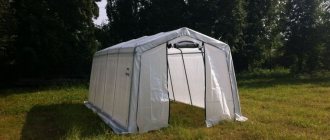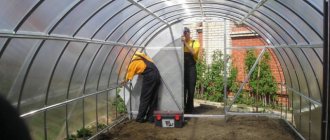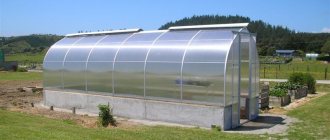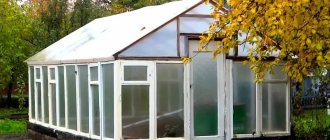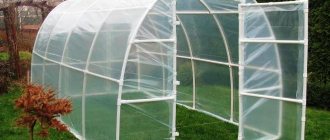Strengthening methods
There are several methods to make a structure stronger and more reliable, spending a minimum of effort and money.
It never hurts to additionally strengthen even the most durable structures. But before this, an inspection should be carried out to detect “weak” spots. This may be the manifestation of corrosion on metal elements or the formation of mold on wooden parts. In addition, other defects can be detected.
To avoid destruction of the frame, it is necessary to clean its surfaces from time to time, as well as treat them with special compounds. The affected areas of the structures must be cleaned with fine-grained sandpaper and then covered with:
- antiseptic;
- varnish;
- anti-corrosion agent.
In addition to protective measures, there are some instructions on how to strengthen the greenhouse.
Choosing a fertile place
It is very important to choose the right location for the greenhouse. The area should be flat, not shaded, and there should be no buildings or large trees at a distance of 3 meters. Trees not only create shade, their root system will interfere with the development of plants in the greenhouse, and nearby buildings contribute to the appearance of drafts. The greenhouse must be oriented to the cardinal points. The correct location would be from east to west in length, then one wide side will always face south, and this will provide the greatest amount of sunlight.
Another advantage of a mobile greenhouse is that if you choose the wrong location, it’s only for one year; next year you won’t repeat the same mistake.
Duplicate arcs
Using special devices, it is necessary to bend arcs that repeat the configuration of the main structural elements; naturally, they will turn out to have a smaller radius.
They can be made from reinforcement, metal profiles or pipes. Then weld them to the load-bearing arches using jumpers made of the same material.
Often, reinforcement is made with additional arches of the same radius as the structure itself, placing them side by side at approximately a meter distance.
How to strengthen a polycarbonate greenhouse for the winter with your own hands. With your own hands
What to do if you don’t have a welding machine, the financial ability to call specialists and buy materials, and winter is already approaching? We strengthen the greenhouse with our own hands using improvised means:
- Let's prepare poles (you can use a block or small trees), the main thing is that the material is strong, with a cross-section of at least five centimeters;
- We attach the reinforcement to the main frame using wire or cord; in addition, it is better to use self-tapping screws;
- Let's duplicate the horizontal longitudinal parts of the greenhouse skeleton and the ridge with wood;
- We fasten the crossbars along the width of the building in increments of no more than a meter, here it is better to use long poles without connections, they should rest against the walls of the greenhouse at the transition from the walls to the roof, fixing the structure;
- To prevent the frame from being pushed inward, we install support pillars;
Pay attention to the joints of the reinforcing elements, provide recesses for a tighter fit!
- To protect from the wind, we use long pieces of reinforcement, deepening them into the ground outside the greenhouse.
This method does not require financial investment, but hard work and attention. In winter, it is advisable to check the structure after heavy snowfalls and regularly remove the “snow cap”.
Each summer resident determines for himself how to strengthen the frame of his greenhouse with a polycarbonate coating. In the process of use, it improves and complements the design using more modern materials. The main thing is not to forget that any structure requires attention, especially in winter.
Supports
The simplest and most common method of strengthening a greenhouse is supporting the frame with durable materials (timber, boards, pipes, etc.).
Supports in the greenhouse can be in two versions:
- Along the base elements, longitudinal supports are installed to support the roof.
- Strengthening the transverse arches with supports.
Many additionally strengthen the roof ridge with vertical supports. You can see visual examples in the photo of how you can strengthen a greenhouse.
Preparing timber
We cut the beam to the size of the greenhouse: the outer perimeter of the base should correspond to the inner perimeter of the greenhouse. We treat the wood with a special antifungal impregnation to protect the wood in conditions of high humidity and biodegradation. This important stage should never be skipped, otherwise the timber may rot within a few years. For this reason, it is recommended to process twice. After the wood has dried, you can begin installation.
Replacing cladding material
Before strengthening the frame, you need to pay attention to the condition of the polycarbonate sheets and their thickness.
Budget options are often equipped with polymer material four millimeters thick. Which is not suitable for long-term use. Polycarbonate panels should be used in thickness:
- for walls - 6mm;
- for a gable roof - 8mm.
Autumn-winter period
Such a greenhouse needs real care in the fall, that is, after harvesting. In order to prepare for winter, the first step is to do some general cleaning. All upcoming work can be divided into 5 stages:
- Cleaning the greenhouse. The first step is to remove plant remains from the greenhouse, take out bags of fertilizers, seed containers and pots. Collected plants can either be composted or burned.
- Soil treatment. The best option is to replace the top ball of soil mixture (about 5 cm), since it has become depleted over the season. As a last resort, the soil must be treated with a bactericidal preparation or scalded with boiling water.
- Fertilizer application. To improve the quality of the soil mixture, you can sow green manure plants such as mustard or rapeseed. Before sowing, it is worth revitalizing the soil with complex mineral fertilizer for greens and seedlings or simply humus and compost.
- Disinfection. After cleaning the greenhouse, you need to thoroughly wash the polycarbonate with dishwashing detergents and a soft sponge. Then it is necessary to treat all elements of the greenhouse structure, since there may be insects in the cracks of the frames. To disinfect hard-to-reach places, you can use a sprayer with a long nozzle. In this case, you can only use those products that are recommended by the manufacturer of cellular polycarbonate.
- Greenhouse conservation. After cleaning, you need to check and close all hinges and latches on the windows and doors. It is advisable to strengthen the frame with additional supports so that it can withstand high snow pressure. If the foundation masonry has cracked, it must be repaired, since in the cold it will spread even more.
- maintaining the cleanliness of the coating (if the outer surface of the polycarbonate is clean, snow will not linger on it);
- clearing snow drifts deeper than half a meter around the greenhouse;
- removing snow on the roof if its layer exceeds 10 cm (this can be done by simply tapping the polycarbonate from inside the greenhouse with your hand).
No special care is required for a polycarbonate greenhouse in winter. Moreover, if it is stationary and manufactured at the factory. As a rule, winter greenhouse care comes down to the following:
The soil inside the greenhouse should be sprinkled with a thin layer of snow to protect it from freezing and to moisten it with melt water in the spring.
Features of strengthening
You should remember the period when you need to take on strengthening the structure. The supports must be installed before the onset of cold weather, before the soil is completely frozen.
The biggest problem is caused by temperature changes, which cause soil heaving. This can cause the reinforcement supports to be pushed out and cause internal damage to the greenhouse.
Strengthening the frame is only a small part of the work; first you need to take care of the foundation of the structure. In order for the greenhouse to stand firmly in its place, despite strong gusts of wind, it is worth building a strip foundation under it. This will help avoid many problems in the future.
During operation, any foundation can crack. In this case, it is necessary to urgently correct the situation. Often the problem is resolved in the following way:
- identify the exact location of the crack;
- dig the foundation in this place;
- fill the crack with a special solution.
You have to dig very carefully to prevent the crack from going further.
What does strength depend on?
As has already become clear from the above, the roof can collapse due to a weak foundation. Manufacturers often save on the cross-section of galvanized profiles. At the same time, their products become cheaper and more accessible, but their quality drops noticeably. You can solve this problem in the following ways:
- dismantle the building for the winter;
- periodically remove snow from the roof of the finished structure;
- install special supports (although this does not guarantee the integrity of the building);
- buy a model with a reinforced frame;
- strengthen the base yourself by constructing it from wood or profile.
The planned repair of a structure and its strengthening, of course, begins with an inspection of the structure, including all the little things. First of all, polycarbonate is carefully inspected . Particular attention is paid to all its cracks, dents, and swellings. Cloudiness can also be a cause for concern. In addition, the entire building is checked for tilt or distortion. It is best to use a level for this purpose.
If no damage is observed, the walls of the greenhouse can simply be washed inside and out, disinfected and, if necessary, partially replaced with soil. Well, if damage is still found, the greenhouse will need to be strengthened.
Frame problems
Often simple wooden frames of greenhouses are installed on sites. Many are secured to the ground using L-shaped brackets. They are bent reinforcement bars with dimensions:
- diameter - 0.95cm;
- pressing side - about 20cm;
- the side driven into the soil is 45 cm.
Most problems with a structure do not happen instantly. For example, the tilt of the entire structure occurs gradually. But when metal parts suddenly bend or boards break, you need to react immediately:
- straighten the metal as smoothly as possible;
- put together the boards using overlays.
To avoid repeated damage, the repaired areas must be reinforced with additional supports. If it is possible to completely replace the problematic part, it is better to do so. But this should be done in favorable weather.
How to secure a greenhouse from the wind. How to cover and secure the film on a greenhouse
Instructions for attaching the film to the frame:
- Do not cut out the rolls before starting work. Throw the roll over the arc.
- Stretch the fabric so that there is room for fastenings on both sides (20-25 cm). Cut the desired piece.
- Repeat the steps, covering the empty spaces on the frame with an overlap.
- Place the strips on the surface. Use tape to glue the parts together.
- Lay and secure to the frame.
- Now cut out the end parts with a margin. They also need to be fixed.
- Cut out blanks for windows and doors and attach.
Advice! In order for the tape to reliably fasten the parts together, a degreaser must be applied to the gluing areas.
The service life of the arc greenhouse depends on how correctly the film is attached. If his skeleton is made of a metal pipe, you need to put a piece of plastic pipe or an old hose on it.
The illustration for the article is taken from open sources
You can stretch white fabric over the profile. In this way, it will be possible to protect the polyethylene from overheating in places where it comes into contact with the metal surface.
As a rule, summer residents secure the canvas with a strong fishing line or cord. The thread is fixed in the corner at the bottom of one side of the greenhouse. Then, under tension, it is lifted upward from one edge to the other (zigzag).
Exactly the same manipulations must be performed inside the structure. The film should be between the stretched fishing line.
Other methods:
- For a structure made of plastic pipe, pieces of pipe of larger diameter will be required.
- For reinforcement structures, use binders.
- If the arches are made of wood, the film can be secured with nails or screws. To prevent damage to the polyethylene sheet, secure it with wooden pads.
Thermoplastic problems
Polycarbonate sheets must be replaced if:
- the material has become cloudy or darkened;
- moisture forms in the honeycombs;
- deformation of the panels occurs in hot weather.
If there is a possibility and special means, then you can try to eliminate these defects, but most often you have to completely change the defective sheets.
Base installation
For a greenhouse measuring 6x4 m, it is recommended to use six grousers. These are T-shaped legs 30-50 cm high, which can be purchased separately or made independently. We used 50cm lugs. We mark the dimensions of the base on the site, check the diagonals and dig six holes around the perimeter of the greenhouse, corresponding to the size of the legs. We install the lugs and fix them with self-tapping screws to the assembled base.
Checking the level. If there is a difference in height on your site, the timber can be buried in the ground on one side. Then we check the diagonals again: they should be the same. And only after that we dig holes.
Reinforced greenhouses
For a long time, most summer residents prefer to install reinforced greenhouses. Such structures have a special design that adequately withstands harsh natural phenomena, which allows greenhouses to serve for years.
spring-cleaning
In the fall, the greenhouse needs to be thoroughly cleaned. All plants are uprooted and removed. It doesn't matter if the plants are annuals or perennials basking in the warm, humid greenhouse climate. They cannot be left over the winter. They can become a source of diseases for new plants. Annuals should be pulled out and disposed of. Diseased leaves of perennials are removed, then the plants are dug up by the roots. In the spring, new young specimens are planted.
After the plants are removed, the greenhouse needs to be washed. To avoid leaving scratches on the covering material, you need to use a soft cloth. A sponge will also do. Dirt is washed off with a soapy water solution. Then everything needs to be rinsed with clean water. After arranging ventilation, dry the greenhouse.
Design Features
The main differences of the reinforced structure:
- metal used for the frame is at least 1.2 mm thick;
- double arcs;
- the frame is equipped with transverse and longitudinal jumpers;
- arched structures have a horizontal guide under the roof ridge;
- the gap between the arches is from 40 to 60cm;
- polycarbonate is more than 4 mm thick and has a high density;
- the presence of cross connectors between the elements of the structure;
- arch cross-section of at least 20mm.
The most durable structures are those made from non-removable arches made of thick metal. In addition, the assembly of a reinforced greenhouse of this type is simpler and occurs much faster.
Whether to purchase a reinforced greenhouse or carry out work to strengthen the structure with your own hands depends on personal preferences, capabilities and certain factors.
What can damage the base?
Conventional arched greenhouses are distinguished by a shape that is very convenient for snow sliding off. But why does it still accumulate on their roofs?
The point here is the properties of cellular polycarbonate. In winter weather, even if the temperature drops to -15°C, inside the building it is up to +5°. The surface heats up, snow melts on it, which freezes when the sun rises. The roof becomes rough, which forms the basis for the accumulation of a solid snow cover, the weight of which sometimes reaches up to 80 kg.
Now let's compare. The “skeleton” of a greenhouse is usually made of metal profiles, which is the most common material. And the load it can withstand is no more than 50 kg/m2 . It is absolutely obvious that the structure needs to be strengthened.
The safest covering material is glass, under which a strong base is usually made in a greenhouse. In the case of such a roof, you don’t have to worry about piles of snow. If you choose polycarbonate, it is best to buy its sheets with a thickness of 6 millimeters or more. They will not bend under the weight of the snow cap.
Interesting. You can build a durable winter greenhouse with your own hands!
